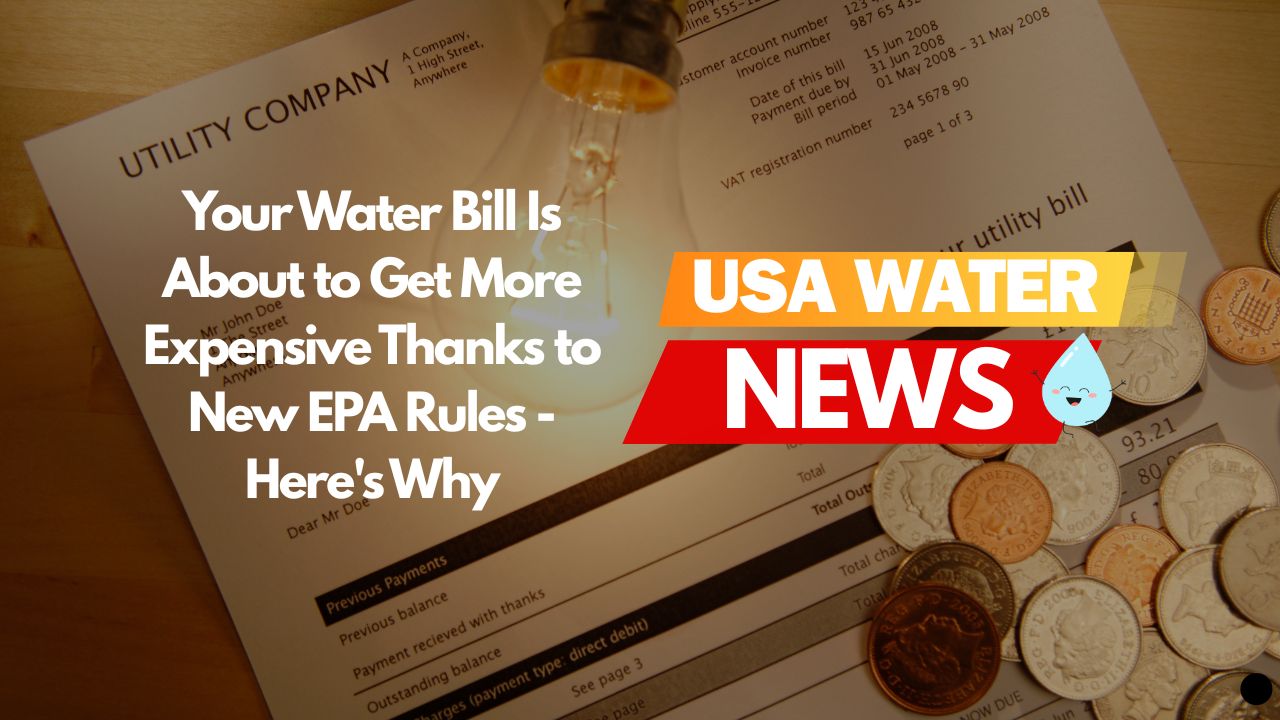If your water bill has been climbing lately, you’re not imagining things. There’s actually a specific reason behind those higher costs that most people don’t know about yet.
Water companies across America are dealing with expensive new rules from the EPA about testing for “forever chemicals” in our drinking water. These chemicals – called PFAS – are seriously nasty stuff that’s been found pretty much everywhere, and now utilities have to spend big money to find them and get rid of them.
Here’s the thing though: a lot of these costs are getting passed straight to us customers. We’re talking about billions of dollars in total expenses that could really hit your monthly budget.
What This Actually Means for Your Wallet
The bottom line: Yeah, you’ll probably pay more for water. But here’s the trade-off – you’re getting way better protection from chemicals that can literally cause cancer.
The EPA figures that somewhere between 6% and 10% of America’s 66,000 water systems are going to have to make some serious changes. And honestly? The cost impact is already hitting some families pretty hard.
What you can expect to pay:
- Some places are seeing water bills jump 13-50%
- A bunch of communities are already dealing with 18-30% increases
- If you’re in a smaller town, your water system might get hit the hardest
When this is all happening:
- Water companies have until April 2027 to finish their initial testing
- They’ve got until 2031 to actually fix any problems they find (the EPA pushed this back from 2029)
- You’ll start seeing these costs show up in your bills over the next couple years
The good news part: This whole thing is supposed to protect about 100 million Americans from PFAS exposure. The EPA thinks it’ll prevent thousands of deaths and cut down on tens of thousands of serious health problems. So there’s that.
Here’s What’s Actually Driving These Costs
The testing part is expensive:
The EPA dropped these new rules back in April 2024 – the first time ever that there have been federal limits on PFAS in drinking water. But here’s the kicker: the testing they require is incredibly sophisticated and pricey.
Water companies have to use these specific testing methods called EPA Methods 533 and 537.1. These aren’t your basic water tests. We’re talking about equipment that can find chemicals at levels so tiny it’s like finding a single drop in an Olympic swimming pool.
What water companies have to do now:
- Test for 29 different types of PFAS chemicals (not just a few)
- Use labs that are specially certified for this type of testing
- Keep monitoring all their water sources on an ongoing basis
- Do follow-up testing if they find any contamination
The treatment costs are where it gets really expensive: When PFAS levels are too high, utilities can’t just ignore it. They have to install treatment systems that cost serious money:
- Activated carbon filtration systems
- Reverse osmosis treatment (the really expensive stuff)
- Ion exchange technology
- Sometimes they even have to drill completely new wells
Some real examples that’ll make your jaw drop:
- One water treatment plant in Massachusetts cost $16 million to upgrade. That’s four times what they usually spend in an entire year
- In Hudson, Massachusetts, people’s water bills went up 18% because of PFAS cleanup
- Wellesley, Massachusetts got hit even worse – 50% increases
- Depending on what needs to be done, new wells can cost anywhere from $5,000 to $2 million
Why We’re Dealing With This Now
For years – decades, really – these PFAS chemicals have been getting into our water supply with basically no oversight. Recent EPA data shows there are now 9,323 contaminated sites affecting about 165 million Americans. That’s a lot of people drinking contaminated water without even knowing it.
The new regulations go after six specific PFAS chemicals, and the limits are super strict:
- PFOA and PFOS: Only 4 parts per trillion allowed (these are the really bad ones)
- PFNA, PFHxS, and GenX: 10 parts per trillion limit
- PFAS mixtures: They use something called a “Hazard Index” to calculate safe levels when multiple chemicals are found together
Here’s why they’re being so strict about the limits: This stuff literally never goes away. PFAS chemicals don’t break down in nature, and they build up in your body over time. Even super tiny amounts have been linked to:
- Kidney and testicular cancer
- Liver problems
- Immune system damage
- Developmental problems in kids
- Making vaccines less effective
The testing is genuinely challenging: Those EPA testing methods I mentioned? They can detect PFAS at parts per trillion levels. To put that in perspective, that’s like finding a single second in 32,000 years. You need seriously expensive lab equipment and specially trained technicians to pull that off.
What You Can Actually Do About This
Get the facts about your costs:
- Call up your water company and straight-up ask them about rate increases coming because of PFAS compliance
- Find out if they’ve already tested for PFAS and what they found
- Ask whether they’re planning to install treatment equipment or if they’ll need to find new water sources
Know what options you have:
- You might want to look into a home water filter that’s certified to remove PFAS while you wait for your utility to get their act together
- Look for filters that have NSF certification – specifically reverse osmosis or activated carbon systems that are proven to work on PFAS
- Keep in mind that your water company has to tell you if PFAS levels go over the federal limits
Stay in the loop:
- Your utility has to finish their initial PFAS testing by 2027
- You should get annual water quality reports that show PFAS test results
- When they want to raise rates, there are usually public hearings where you can actually speak up
💡 Here’s what you should do right now:
- Get your water quality report: Call and ask for the latest PFAS test results – don’t just wait for them to mail it
- Start budgeting: Plan for your water bill to potentially go up 15-30% over the next few years
- Research filters: Look into certified PFAS removal systems for your home, especially if you’re in a high-contamination area
What’s Coming Next
There is some financial help available: The EPA has set aside $1 billion specifically to help water companies deal with PFAS requirements. This money covers:
- Technical help for testing and treatment
- Funding targeted at small and disadvantaged communities
- Support for people with private wells who are dealing with contamination
Here’s the timeline for all this:
- 2025-2027: Water companies do their required PFAS testing
- 2027: They have to tell customers what PFAS levels they found
- 2027-2031: Companies that found too much PFAS have to fix it with treatment or new water sources
- 2031: Everything has to be in full compliance
Who’s going to get hit hardest with costs: Experts think the biggest financial impact will be on:
- Small rural water systems (they don’t have as many customers to spread the costs around)
- Communities near places where PFAS contamination is known to be bad (military bases, airports, industrial sites)
- Systems that use groundwater instead of surface water (groundwater tends to be more contaminated)
Policy stuff that might change: The EPA has hinted they might only keep the rules for the two most well-studied PFAS chemicals (PFOA and PFOS) and reconsider the other four. This could cut some of the compliance costs, but it would also mean more chemicals stay unregulated.
The Real Talk
Look, nobody likes paying more for something they’re already getting. But here’s the reality: these higher water bills reflect decades of basically ignoring a problem that was getting worse and worse.
The costs are real, and they’re significant. But what you’re paying for is testing that can catch harmful chemicals at incredibly low levels and treatment systems that can actually remove them from your drinking water.
For a lot of families, it’s going to come down to either paying more for cleaner water through your utility or spending money on home filtration systems. Either way, protecting yourself from PFAS is probably going to cost more than it used to.
My advice? Stay engaged with your local water utility. Ask questions about their PFAS plans and timeline. A lot of them are trying to minimize the sticker shock by using federal funding and rolling out changes gradually.
But at the end of the day, this is about getting chemicals out of our water that have been linked to cancer and other serious health problems. That’s worth something, even if it costs more.
Sources: Environmental Protection Agency PFAS regulations (April 2024), NBC News analysis of water utility costs, EPA Methods 533 and 537.1 documentation
Last Updated: June 28, 2025
Check your water now!
We have translated and compiled water reports on every state in the US, and covered over 100 cities. Find out how good your water is today!

Please read – our information
The information presented on cleanairandwater.net is compiled from official water quality reports, trusted news sources, government websites, and public health resources. While we strive for accuracy and thoroughness in our presentations, we are not scientists, engineers, or qualified water quality professionals.
Our mission is to present water quality information in an accessible, real-world format that helps people understand what’s in their water and make informed decisions about their health and safety. We believe that complex environmental information should be available to everyone in a format that’s easy to understand.
We make every effort to ensure our content is current and accurate, but we cannot guarantee that all information is complete or error-free. This website should not replace official communications from your local water utility or health department. We always recommend consulting official sources for the most up-to-date information regarding your specific water system.
Clean Air and Water is not liable for any unintentional errors, omissions, or outdated information. The content on this site is provided for informational purposes only and should not be considered professional advice.

